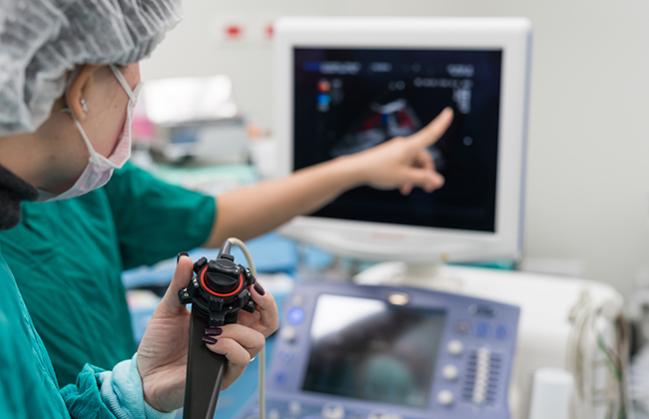No Harm Done: Foregoing Routine TEE and General Anesthesia in TAVR
In a single-center study, patients treated under TTE and monitored anesthesia care saw streamlined procedures and similar safety.

Hospitals that shift away from routine use of transesophageal echocardiography (TEE) and general anesthesia during TAVR to an “as-needed” mentality stand to gain shorter procedures and hospital stays without any rise in complications or 30-day readmissions, a single-center study confirms.
TEE’s use for periprocedural monitoring has been widely recommended in expert consensus statements and in clinical trial protocols, researchers note in their paper, which was recently published online in the American Journal of Cardiology. It enables “prompt recognition of perioperative complications like significant paravalvular regurgitation, valve dislodgement, coronary artery occlusion, cardiac tamponade, aortic dissection, aortic annular rupture, etc, and can help guide management,” they say.
But these assets don’t seem to confer any improvement in clinical outcomes, they point out. As multiple studies are starting to show, advances in TAVR technology and growing experience are smoothing the transition to transthoracic echocardiography (TTE) and monitored anesthesia care (MAC).
“The main advantage of doing the minimalist versus the usual, prior approach is basically saving on procedural time,” lead author Udit B. Bhatnagar, MD (Sanford Health, Sioux Falls, SD), told TCTMD. “Just by how [TTE is] designed, it reduces length of stay and reduces the need for general anesthesia,” which itself can be associated with complications. All this stands to reduce costs as well, he added.
“It does work, when the right patients are chosen,” Bhatnagar advised, pointing out that heart-team discussion is key in making the decision to proceed with a more minimalist approach.
Complications, Echocardiographic Outcomes Similar
The researchers retrospectively examined results for 178 patients treated at their hospital between September 2012 and February 2017. Whether to use TEE was made on a case-by-case basis, with 58.4% of patients ultimately having TEE during their procedures.
“Patients undergoing TAVI with a nonfemoral approach or requiring vascular cutdown were done under general anesthesia” with concomitant TEE guidance, Bhatnagar and colleagues explain. “Generally, patients with higher comorbidities tended to be done under general anesthesia, although some patients with very severe comorbidities—who were not anticipated to do well under general anesthesia—underwent the procedure under MAC and TTE guidance.”
Importantly, all patients had preprocedural TEE or cardiac CT for annular sizing. In the cases without periprocedural TEE, both “TTE and fluoroscopy were used for valve positioning,” the researchers say.
Baseline characteristics such as previous comorbidities, surgical risk score, and level of frailty were similar in the two groups. Use of self-expanding versus balloon-expandable valves was evenly distributed. Most patients (91%) were treated using a transfemoral approach.
Overall procedure time was longer with TEE (mean 107 vs 83 mins; P = 0.0002), as was length of stay (mean 5.01 vs 2.49 days; P < 0.0001). Fluoroscopy time and contrast use were similar regardless of whether TEE was employed. So too were the rates of most periprocedural and in-hospital complications; one exception was a higher need for pacemaker with TEE (12.5% vs 2.7%; P = 0.025). Postprocedure gradients and velocities across the aortic valve did not differ by TEE use. Thirty-day readmission rates were 17.3% with TEE and 12.2% without TEE (P= 0.3456).
Citing the retrospective nature of the study, the researchers acknowledge that it did not take into account evolving experience and technology. Also, they add, there’s the possibility that factors informing the decision to use TEE might lead to confounding.
Bhatnagar et al call for future randomized studies to compare the two approaches. “With the evolution of TAVI technology, newer transcatheter valves, and increasing operator experience, ‘routine’ need for intraprocedural TEE may be diminishing,” they conclude.
Caitlin E. Cox is News Editor of TCTMD and Associate Director, Editorial Content at the Cardiovascular Research Foundation. She produces the…
Read Full BioSources
Bhatnagar UB, Gedela M, Sethi P, et al. Outcomes and safety of transcatheter aortic valve implantation with and without routine use of transesophageal echocardiography. Am J Cardiol. 2018;Epub ahead of print.
Disclosures
- The authors did not report any information on potential conflicts of interest.


Comments